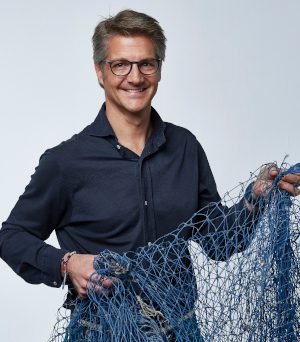
The glasses that save the oceans.

Since 2016 Sea2see has started a revolutionary process to recover plastic abandoned in the seas and use it as raw material to create glasses. For each frame, the company collect and recycle around 5 kg of plastic. We discussed the subject in depth with François van den Abeele, founder and CEO of the brand.
Could you tell us the main point and focus of your project?
There are three key areas in what we do: We have pioneered the use of marine plastic as a source of raw material. Since 2016, Sea2see has been proving that waste – and in our case – marine plastic – can be used successfully as a raw material in the optical industry.
When we first started in this industry, issues around sustainability were something that people didn’t seem to care about and so we’ve been pioneering the use of a new raw material, a new resource that in the end, is having an impact just through the activity of removing the waste from the sea. Obviously our company has always had a strong focus on the environment and that will always remain the drive for what we do – having a real and visible impact at the source of the problem.
We have also developed a plastic collection program in countries where we have a direct social and environment impact on the coastal communities. We have developed and created an inclusive supply chain where waste has value – we have managed to create a sustainable and a scalable solution that is reducing marine plastic on the one hand and improving the lives of marginalised coastal communities by bringing them a new source of income, whilst also cleaning their beaches and coastlines.
Raising awareness about the issue of Ocean plastic and making our consumers part of our story is fundamental to Sea2see. For each frame, we collect and recycle around 5 kg of plastic. We have been creating awareness over this time about the real issue we face with marine plastic and we have been making consumers a part of what we do. Consumers are changing – they are looking to buy differently.
We are actually giving them an easy solution – being something that they can wear - to be a part of this ecological shift towards sustainability. SO they are directly contributing to the financing of the collection and the transformation of waste.
We promote a circular economy and sustainability in the Optical sector, where recycling was not considered an issue 5 years ago.
I have been pushing for this focus on sustainability in the optical industry for four years and I will continue to disrupt and promote this opportunity for real change in this industry, where so much virgin plastic and hardly any recycled materials had arrived in the marketplace until we created Sea2see.
What kind of collaboration links you to the fishermen?
We have 2 types of collaboration. In Africa, we are already working in Ghana and in Senegal and we will soon move into the Ivory Coast and Conakry Guinea, by 2021. We are looking to expand into Asia/ Indonesia as well.
The program in Africa rewards the fishermen for cleaning the environment and providing a new source of income for the amount of waste they collect. It is great to see that they collaborate because of course they can make money out of it but also because they see with their own eyes that they can make an impact themselves on the environment.
The objective is to expand our collection program around the world.
In Europe we started in Spain and then France, by placing containers at the ports and working with the fishing communities to collect marine waste. We have a collaboration with 27 ports in Spain and 12 ports in France today.
A selection of the waste material is made by the fishermen in the port – they are happy to do this and they value that whatever they collect can be given a new life and not stay and pollute the marine environment. We provide the tools, the containers, and the big bags to collect the waste.
How many tons of plastic have you collected? How many on average per year?
So far in the first year about 50 tons, the second year about 100 and in 2019 we collected a total of 160 - and the same again in 2020 so far.
In Ghana alone right now we are collecting on average 10 tons per month. Our objective is to collect around 350 tons a year in total in 2021.
Would you describe the process of transformation from abandoned plastic to the creation of sunglasses?
The process starts with the collection of the waste, thanks to the fishermen. The second step is the separation of what can and can’t be used for the raw material – this is done manually.
Once the material is separated and we have clearly identified what works best for our frames and watches soon, then that polymer is being recycled – once we have created a “reusable” raw material through this process – then we follow the typical steps of manufacturing our glasses in Italy.
The initial steps are really important to be able to create a high quality material that we can use successfully for the frames.
What is your strategy for the distribution of your eyewear?
We have achieved a strong and fast-growing global distribution which we are really excited by, and this has been the case even in this difficult year.
Currently, in some markets we have our own reps, and in some markets we are working with distributors.
We also work with well-known chains in Scandinavia, France and North America, and we also do collaborations and co-branded collections with 3rd parties.